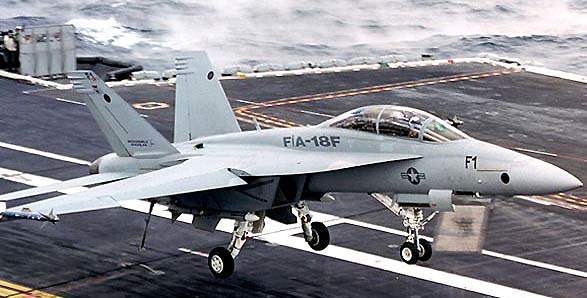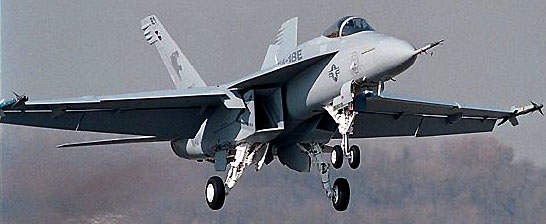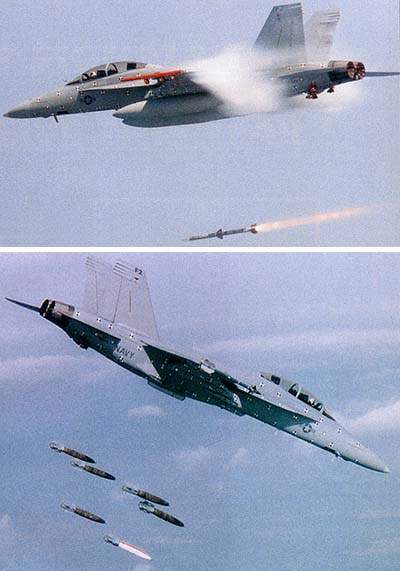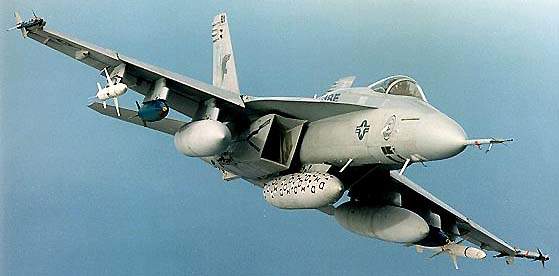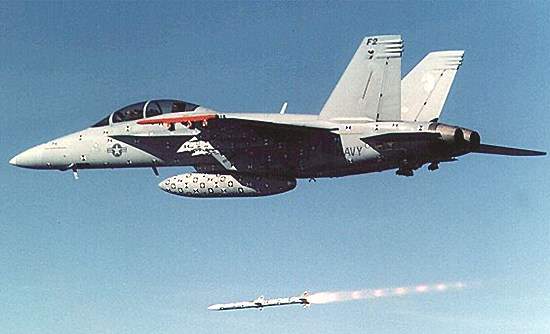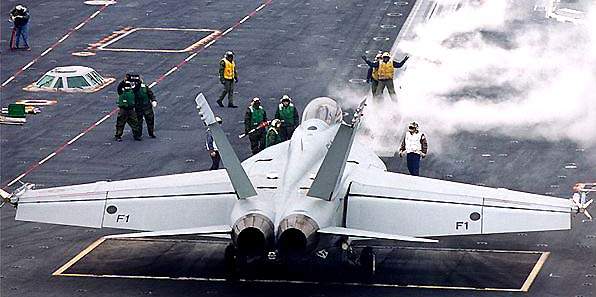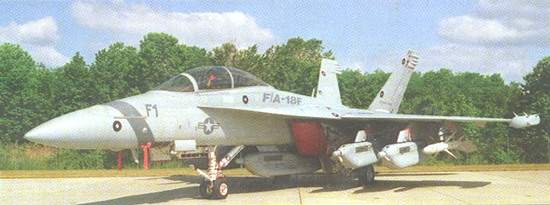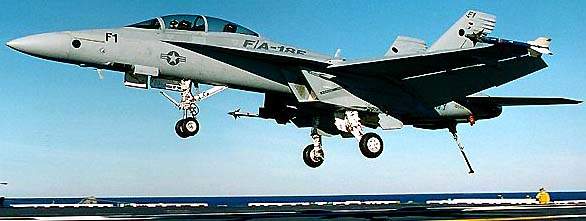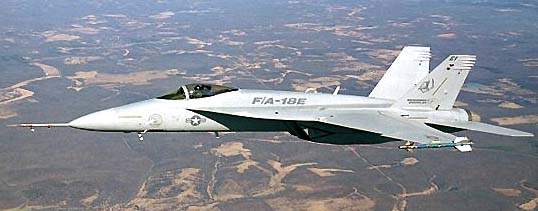The US Navy F/A-18 E and F Super Hornet maritime strike attack aircraft, manufactured by Boeing, flew for the first time on November 29 1995. The Super Hornet is about 25% larger than its predecessor, the F/A-18C/D, but contains 42% fewer structural parts. The single-seat F/A-18/E and the two-seat F/A-18/F fly greater ranges with heavier payloads, have more powerful engines and provide greater survivability.
Orders and deliveries
The first low-rate initial production aircraft was delivered in December 1998, and all 12 of the first batch were delivered by November 1999.
In February 1999, the US Navy placed an order for 30 Super Hornets, in addition to the 12 already ordered. Following successful completion of operational evaluation, in June 2000 the USN ordered 222 fighters to be produced over five years.
The first full-rate production aircraft was delivered in September 2001.
A second multi-year contract was signed in January 2004 for 42 aircraft to be purchased between 2005 and 2009. Total requirement was for at least 545 aircraft. As of April 2011, over 500 aircraft have been delivered.
In July 2002, the F/A-18E/F began its maiden operational deployment on board USS Abraham Lincoln (CVN 72). In November 2002, the aircraft made its combat entry, striking air defence sites in Southern Iraq with Joint Direct Attack Munitions (JDAM). The aircraft was also deployed as part of Operation Iraqi Freedom in March 2003.
Improvements scheduled for Block 2 aircraft include a redesigned forward fuselage which has fewer parts and changes to the aircraft’s nose to accommodate the Raytheon APG-79 Active Electronically Scanned Array (AESA) radar. The first aircraft was delivered in September 2003.
The aircraft is fitted with new mission computers, fibre-optic network, Raytheon AN/ASQ-228 ATFLIR targeting pod, Boeing joint helmet-mounted cueing system and Raytheon AIM-9X next generation Sidewinder air-to-air missile.
In April 2007, Boeing announced that it had been asked by the US Navy to provide an Infrared Search and Track (IRST) system for the F/A-18E/F. Boeing has selected Lockheed Martin Missiles and Fire Control to supply the system. In November 2011, the US Navy awarded a $135m contract for engineering and manufacturing development of the IRST sensor system. The IRST system is expected to achieve initial operating capability by 2016.
In February 2007, Australia requested the FMS of 24 F/A-18F Block 2 aircraft. The contract was placed in May 2007. The first five aircraft were delivered in March 2010 and and rest of them were delivered by October 2011. The F/A-18F Block 2 aircraft cover the capability gap between the retirement of the F-111s in December 2010 and the delivery of the first F-35 Joint Strike Fighter to Australia in 2013.
The US Navy has approved System Development & Demonstration (SD&D) for an electronic attack version of the Super Hornet, the EA-18G, to replace the EA-6B Prowler. The EA-18G incorporates the Improved Capability III (ICAP III) suite developed for the Prowler. Two SDD aircraft were delivered. First flight of the EA-18G was in August 2006.
In May 2009, Boeing received a contract worth $48.9m for the development of Distributed Targeting (DT) system for super hornet aircraft.
In November 2011, the US Navy awarded a $48m contract to develop the Type 4 Advanced Mission Computer (AMC) for F/A-18E/F Super Hornet, which will replace the Type 3 AMC currently in use. It is expected to be completed by 2012.
In September 2011, Boeing and the US Navy proposed to offer F/A-18E Super Hornet Block II version aircraft to the Japan Air Self Defence Force (JASDF).
In September 2011, the US Navy awarded a $5.297bn contract that includes delivery of 66 Super Hornet aircraft between 2012 and 2015.
Fighter cockpit
The cockpit in the F/A-18E/F is equipped with a touch-sensitive control display, a larger multi-purpose liquid crystal colour display, which shows tactical information, two monochrome displays and a new engine fuel display. The aircraft retains the mission software and a high proportion of the avionics found in the C/D models.
The cockpit also has a colour digital map and the pilots are equipped with night-vision goggles. The zero/zero ejection seat is the SJU-5/6 from Martin Baker Aircraft Company Ltd in the UK.
Super Hornet Weapons
The Super Hornet has 11 weapon stations which include two additional wing store stations and will support a full range of armaments including AIM-9 Sidewinder, AIM-7 Sparrow and AIM-120 AMRAAM air-to-air missiles, guided air-to-ground weapons such as Harpoon, SLAM/SLAM-ER, GBU-10, GBU-51, HARM and Maverick; and free-fall air-to-ground bombs, Mk-76, BDU-48, Mk-82LD, Mk-82HD and Mk-84. The aircraft can also carry the GPS- / inertially guided JDAM (Joint Direct Attack Munition), JSOW (joint stand-off weapon) and JASSM (joint air-to-surface stand-off missile).
Boeing is the prime contractor for the Joint Helmet-Mounted Cueing System (JHMCS) for the Super Hornet, to be fitted to Block 2 and retrofitted to Block 1 aircraft. Vision Systems International (jointly owned by Kaiser and Elbit) is the major subcontractor. JHMCS is currently in full-rate production. Deliveries of full-rate production systems began in 2005, although the system was deployed operationally during Operation Iraqi Freedom.
The F/A-18E/F new lightweight gun system is the General Dynamics M61A2 20mm Gatling gun, which has a switchable firing rate of 4,000 or 6,000 shots a minute and a fully integrated linkless ammunition feed system.
Countermeasures
The AN/ALQ-124 integrated defensive countermeasures system (IDECM) provides a coordinated situation awareness and manages the on-board and off-board deception countermeasures, the expendable decoys, and signal and frequency control of emissions. The system has been jointly developed by BAE Systems information & electronic warfare systems (IEWS – formerly Sanders) and ITT Electronic Systems.
The IDECM system includes the ALE-47 countermeasures dispenser, the ALE-50 towed decoy and the AN/ALR-67(V)3 radar warning receiver. IDECM began operational evaluation in December 2002 and was successfully deployed during Operation Iraqi Freedom.
The BAE Systems Integrated Defense Solutions (formerly Tracor) ALE-47 countermeasures dispenser system is capable of dispensing chaff cartridges, flares, and the POET and GEN-X active expendable decoys.
The ALE-50 Towed Decoy, from Raytheon E-Systems, provides long-range detection and extremely fast deployment against most radar-guided threats.
BAE Systems AN/ALE-55 fibre-optic towed decoy has completed development testing and will replace the ALE-50 from December 2009 when it enters service. The Raytheon AN/ALR-67(V)3 radar warning receiver intercepts, identifies and prioritises threat signals, which are characterised in terms of frequency, amplitude, direction and pulse width.
Sensors
The Super Hornet is equipped with the APG-73 radar manufactured by Raytheon. The APG-73 radar has an upgraded processor with increased speed and memory capacity in comparison to the AN/APG-65, which was installed on the earlier builds of the Hornet. The modes of the APG-73 include air-to-ground tracking, air-to-air velocity search mode, range while search and track while scan.
Raytheon’s AN/APG-79 Active Electronically Scanned Array (AESA) fire control radar will increase the F/A-18’s air-to-air target detection and tracking range and provide higher resolution air-to-ground mapping at longer ranges. The The AN/APG-79 AESA entered Low Rate Initial Production (LRIP) in September 2003 and began Operational Evaluation (OPEVAL) in July 2006. It is being fitted to block 2 aircraft and retrofitted to 135 block 1 aircraft. The radar is planned to begin operational deployment on the USN F/A-18s in 2008.
The aircraft is being fitted with the Raytheon AN/ASQ-228 ATFLIR (Advanced Targeting Forward-Looking Infrared) precision targeting pod. ATFLIR consists of a 3-5 micron staring focal plane array targeting FLIR, BAE Systems Avionics high-powered diode-pumped laser spot tracker, BAE Systems Avionics navigation FLIR and CCD TV camera. Initial Operating Capability (IOC) was achieved in April 2003 and the system is now in full-rate production.
US Marine Corps aircraft are being fitted with the Northrop Grumman Litening AT Advanced Targeting pod, with 540 x 512 pixel FLIR, CCD TV, laser spot tracker, infrared laser marker and infrared laser rangefinder / designator.
F/A-18F aircraft also being fitted with the Raytheon SHARP multi-function reconnaissance pod, set to replace USN Tactical Airborne Reconnaissance Pod (TARPS), currently flown on the F-14 Tomcat. SHARP is capable of simultaneous airborne and ground reconnaissance and has sensors manufactured by Recon/Optical Inc. 16 LRIP systems have been ordered and the first was delivered in April 2003. The system is deployed on aircraft operating from USS Nimitz carriers.
Engines
The aircraft’s power is provided by two F414-GE-400 turbofan engines from General Electric. The engines are an advanced derivative of the GE F404 engines installed on the Hornet. The air inlets have been enlarged to provide increased airflow into the engines.
The engines each provide 22,000lb thrust, with afterburn giving a maximum speed in excess of Mach 1.8.
The structural changes to the airframe on the F/E variant of the aircraft increase the internal fuel capacity by 3,600lb, a 33% higher fuel capacity than the F-18C/D variant. This extends the mission radius by up to 40%.

